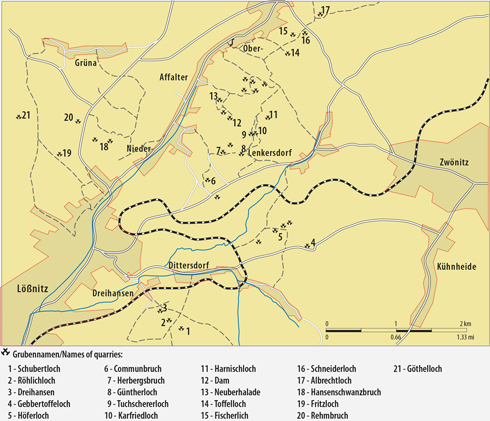|
Slate deposits of Saxony (Germany)
The slate deposits of Saxony are situated within the Erzgebirge (Ore Mountains) between the towns of Lößnitz, Zwönitz and Streitwald as well as north of the town of Rochlitz between the villages Penna and Methau ('Penna roofing slate'). In this chapter only the slates of Lößnitz are described because it was the more important district.
Together with the 'Fichtelgebirge anticlinorium', the 'Erzgebirge anticlinorium' is the southernmost part of the Saxothuringian and represents a NE-SW striking anticline, consisting of different metamorphic rock units.
At the north-western border which is named 'Erzgebirgs-Nordrandzone', the high-grade metamorphic rocks are overlaid by low-grade metamorphic metasediments (Walter, 1995).
The metasediments are generally of Ordovician age and only in the area of the Eibenstock granites close to Einsiedel Silurian and Devonian units are intercalated. This zone is called 'Lößnitz-Zwönitz syncline' and contains the roofing slate deposits.
Due to the lack of fossils a stratigraphic division is almost impossible. Until now only the Lower and Upper Graptolithenschiefer ('graptolithic slate') are definitely detectably and thus the stratigraphic division follows lithological criteria.
New investigations could not lead to new knowledge regarding the stratigraphy of the 'Lößnitz-Zwönitz syncline' (Jacob, 2001).
Within the Lößnitz-Zwönitz Zone Mingram (1996) distinguishes graphite slates, graphitiferous slates and feldspar bearing slates which are combined to the phyillitic unit. The graphite slates represents the Silurian Kiesel- and alum slates. The graphitiferous slates are correlated with the Upper-Ordovician 'Gräfenthaler group' and the feldspar bearing slates with the Lower-Ordivician'Phycodenschiefer' of Thuringia.
Roofing slates were mined in the feldspar bearing slates which build the main portion of the Lößnitz-Zwönitz syncline. This slates show a grey-greenisch, partly reddish colour and are pelitic to siltic slates or phyllites, respectively, as well as quartzitic slates.
The Lößnitz-Zwönitz syncline represents a zone with SE-vergent folding style. It is characterized by an intense folding and imbricate thrusting, the origin of several cleavages or foliations, respectively, and deformation zones. The deformation was characterized by a low-grade metamorphism with temperatures of maximal 752 °F and a low to medium pressure regime (Jacob, 2001).
Abandoned slate quarries between Lößnitz and Affalter.

Roofing Slate Types of the Lößnitz-Zwönitz Syncline
One can basically distinguish three slate types.
-
Bluish, dark-grey to light-grey slates which were mined, for example, in the quarry 'Hasenschwanzbruch', about 0.6 mi. north of the city of Lößnitz. Teuscher (1935) mentioned that these slates are very similar to the slates of Thuringia in respect to the strength, fabric and mineralogical composition. This slates are very hard and durable.
-
Grey-green and relatively soft slates with a moderate splitability were mined between Lößnitz and north of Lenkersdorf. Due to the low hardness, this slates are not very durable and reach only 40 years on the roof. These slates are correlated with the Lower-Ordovician 'Phycodenschiefer' of Thuringia.
-
South of the village Dreihansen in a quarry of the same name, black metallic shining slates were mined. This slates are very hard and resistant and thus could last more than 100 years on the roof. They belong to the phyllitic slates of the Ordovician 'Griffelschieferfolge' ('pencil slate series'; Jacob, 2001).
Pictures
Move mouse over thumb to enlarge.
|

